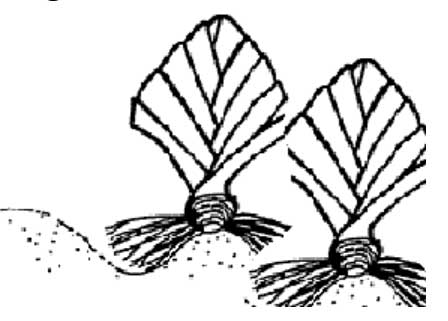Caring for Iris Beds in the Fall
Contact
Plant Diagnostician
Phone: (479) 575-2727
Email: ssmith@uada.edu
Jason Pavel
Diagnostician
Phone: (479) 575-7257
Email: jpavel@uada.edu
University of Arkansas System Division of Agriculture
Cralley Warren Building
Room 16
2601 N. Young Ave.
Fayetteville, AR 72704
Caring for Iris Beds in the Fall
Sherrie Smith and Jason Pavel
September 26, 2022
Plant Health Clinic Disease Note: Issue 31
As we approach fall it is time to clean up our iris beds and divide clumps that have become too crowded. Ideally bearded iris should be grown in full sun in well-drained soils with a pH of 6.0- 7.0. They have very few disease problems when growing conditions are favorable.
That said, prolonged periods of warm, wet weather are advantageous for the development or Iris Leaf Spot, caused by the fungus Didymellina macrospora, synonym Heterosporium iridis.
How can I keep my iris beds healthy?
Removing old foliage in the fall removes much of disease inoculum that otherwise could infect new foliage in the spring. If you live in an area where Iris borer, Macronoctra onusta, is a problem, removing foliage in the fall breaks the reproductive cycle of this insect as Iris borers spend the winter as eggs on old iris leaves and plant debris at the base of iris stalks.
How far back should I prune irises?
Prune back foliage to 6”. Remove completely any obviously diseased foliage.
Dip pruners or scissors in a 10% bleach solution (I part bleach to 9 parts water), between cuts.
When should I divide irises?
Fall is an excellent time to divide rhizomes that have become too crowded. As they age, the original rhizome will stop producing new rhizomes, blooms, and foliage and eventually die.
How should I divide my irises?
Carefully dig up the entire clump. Discard the old rhizomes that are no longer producing and any that do not look strong and healthy. Replant, being careful to leave the tops of the rhizomes exposed. They will not bloom if buried too deeply.
Below is a diagram of proper iris pruning and planting.
The leaves have been pruned back to 6" and the rhizomes are separated into individual plants.
The image above is courtesy of Clemson University, South Carolina.
Take Aways:
- Remove diseased foliage.
- Prune back remaining foliage to 6”.
- Separate crowded clumps and replant healthy rhizomes.
- Fertilize with a low nitrogen fertilizer such as 4-4-2.
This work is supported by the Crop Protection and Pest Management Program [grant no. 2017-70006- 27279/project accession no. 1013890] from the USDA National Institute of Food and Agriculture.
